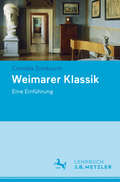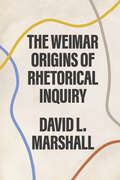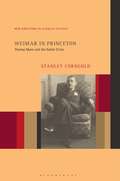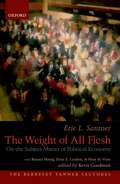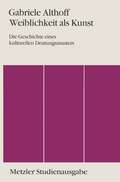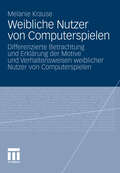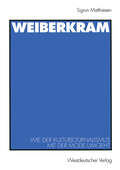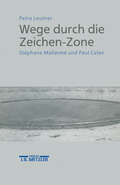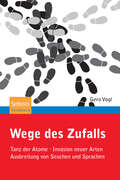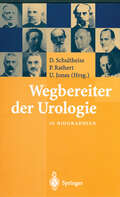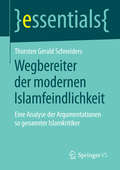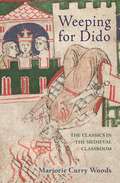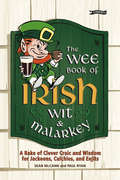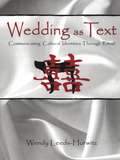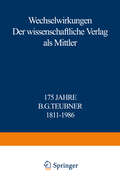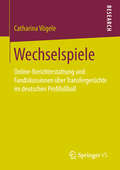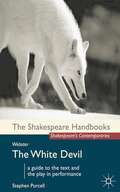- Table View
- List View
Weimarer Klassik: Eine Einführung
by Cornelia ZumbuschDie Weimarer Klassik ist eine zentrale, wenn auch umstrittene Epoche der Literaturgeschichte. Diese Einführung skizziert die Diskussion über eine um Goethe und Schiller gruppierte ›Weimarer Klassik‹ und beschreibt ihre Voraussetzungen, Kontexte und Programmatik. Drei umfangreiche Kapitel stellen exemplarische literarische Werke Schillers und Goethes vor, geordnet nach Lyrik, Dramatik und Erzählformen.
The Weimar Origins of Rhetorical Inquiry
by David L. MarshallThe Weimar origins of political theory is a widespread and powerful narrative, but this singular focus leaves out another intellectual history that historian David L. Marshall works to reveal: the Weimar origins of rhetorical inquiry. Marshall focuses his attention on Martin Heidegger, Hannah Arendt, Walter Benjamin, and Aby Warburg, revealing how these influential thinkers inflected and transformed problems originally set out by Max Weber, Carl Schmitt, Theodor Adorno, Hans Baron, and Leo Strauss. He contends that we miss major opportunities if we do not attend to the rhetorical aspects of their thought, and his aim, in the end, is to lay out an intellectual history that can become a zone of theoretical experimentation in para-democratic times. Redescribing the Weimar origins of political theory in terms of rhetorical inquiry, Marshall provides fresh readings of pivotal thinkers and argues that the vision of rhetorical inquiry that they open up allows for new ways of imagining political communities today.
The Weimar Origins of Rhetorical Inquiry
by David L. MarshallThe Weimar origins of political theory is a widespread and powerful narrative, but this singular focus leaves out another intellectual history that historian David L. Marshall works to reveal: the Weimar origins of rhetorical inquiry. Marshall focuses his attention on Martin Heidegger, Hannah Arendt, Walter Benjamin, and Aby Warburg, revealing how these influential thinkers inflected and transformed problems originally set out by Max Weber, Carl Schmitt, Theodor Adorno, Hans Baron, and Leo Strauss. He contends that we miss major opportunities if we do not attend to the rhetorical aspects of their thought, and his aim, in the end, is to lay out an intellectual history that can become a zone of theoretical experimentation in para-democratic times. Redescribing the Weimar origins of political theory in terms of rhetorical inquiry, Marshall provides fresh readings of pivotal thinkers and argues that the vision of rhetorical inquiry that they open up allows for new ways of imagining political communities today.
Weimar in Princeton: Thomas Mann and the Kahler Circle (New Directions in German Studies)
by Stanley CorngoldThomas Mann arrived in Princeton in 1938, in exile from Nazi Germany, and feted in his new country as “the greatest living man of letters.” This beautiful new book from literary critic Stanley Corngold tells the little known story of Mann's early years in America and his encounters with a group of highly gifted émigrés in Princeton, which came to be called the Kahler Circle, with Mann at its center. The Circle included immensely creative, mostly German-speaking exiles from Nazism, foremost Mann, Erich Kahler, Hermann Broch, and Albert Einstein, all of whom, during the Circle's nascent years in Princeton, were “stupendously” productive.In clear, engaging prose, Corngold explores the traces the Circle left behind during Mann's stay in Princeton, treating literary works and political statements, anecdotes, contemporary history, and the Circle's afterlife. Weimar in Princeton portrays a fascinating scene of cultural production, at a critical juncture in the 20th century, and the experiences of an extraordinary group of writers and thinkers who gathered together to mourn a lost culture and to reckon with the new world in which they had arrived.
Weimar in Princeton: Thomas Mann and the Kahler Circle (New Directions in German Studies)
by Stanley CorngoldThomas Mann arrived in Princeton in 1938, in exile from Nazi Germany, and feted in his new country as “the greatest living man of letters.” This beautiful new book from literary critic Stanley Corngold tells the little known story of Mann's early years in America and his encounters with a group of highly gifted émigrés in Princeton, which came to be called the Kahler Circle, with Mann at its center. The Circle included immensely creative, mostly German-speaking exiles from Nazism, foremost Mann, Erich Kahler, Hermann Broch, and Albert Einstein, all of whom, during the Circle's nascent years in Princeton, were “stupendously” productive.In clear, engaging prose, Corngold explores the traces the Circle left behind during Mann's stay in Princeton, treating literary works and political statements, anecdotes, contemporary history, and the Circle's afterlife. Weimar in Princeton portrays a fascinating scene of cultural production, at a critical juncture in the 20th century, and the experiences of an extraordinary group of writers and thinkers who gathered together to mourn a lost culture and to reckon with the new world in which they had arrived.
The Weight of All Flesh: On the Subject-Matter of Political Economy (The Berkeley Tanner Lectures)
by Eric SantnerEric Santner offers a radically new interpretation of Marx's labor theory of value as one concerned with the afterlife of political theology in secular modernity. What Marx characterized as the dual character of the labor embodied in the commodity, he argues, is the doctrine of the King's Two Bodies transferred from the political theology of sovereignty to the realm of political economy. This genealogy, leading from the fetishism of the royal body to the fetishism of the commodity, also suggests a new understanding of the irrational core at the center of economic busyness today, its 24/7 pace. The frenetic negotiations of our busy-bodies continue and translate into the doxology of everyday life the liturgical labor that once sustained the sovereign's glory. Maintaining that an effective critique of capitalist political economy must engage this liturgical dimension, Santner proposes a counter-activity, which he calls "paradoxological." With commentaries by Bonnie Honig, Peter Gordon, and Hent de Vries, an introduction by Kevis Goodman, and a response from Santner, this important new book by a leading cultural theorist and scholar of German literature, cinema, and history will interest readers of political theory, literature and literary theory, and religious studies.
WEIGHT FLESH SUBJECT-MAT POL ECON BTL C: On the Subject-Matter of Political Economy (The Berkeley Tanner Lectures)
by Eric SantnerEric Santner offers a radically new interpretation of Marx's labor theory of value as one concerned with the afterlife of political theology in secular modernity. What Marx characterized as the dual character of the labor embodied in the commodity, he argues, is the doctrine of the King's Two Bodies transferred from the political theology of sovereignty to the realm of political economy. This genealogy, leading from the fetishism of the royal body to the fetishism of the commodity, also suggests a new understanding of the irrational core at the center of economic busyness today, its 24/7 pace. The frenetic negotiations of our busy-bodies continue and translate into the doxology of everyday life the liturgical labor that once sustained the sovereign's glory. Maintaining that an effective critique of capitalist political economy must engage this liturgical dimension, Santner proposes a counter-activity, which he calls "paradoxological." With commentaries by Bonnie Honig, Peter Gordon, and Hent de Vries, an introduction by Kevis Goodman, and a response from Santner, this important new book by a leading cultural theorist and scholar of German literature, cinema, and history will interest readers of political theory, literature and literary theory, and religious studies.
Weibliche Nutzer von Computerspielen: Differenzierte Betrachtung und Erklärung der Motive und Verhaltensweisen weiblicher Nutzer von Computerspielen
by Melanie KrauseWeiberkram: Wie der Kulturjournalismus mit der Mode umgeht (Journalistik: Forschungsimpulse für die Praxis)
by Sigrun MatthiesenDer herkömmliche Qualitätsjournalismus in Deutschland vernachlässigt das Thema Mode und damit das weibliche Publikum. Das ist das Ergebnis dieses Bandes, der die Mode-Berichterstattung der "New York Times", der "Süddeutschen Zeitung" und der "Frankfurter Allgemeinen" analysiert hat. Die Autorin beläßt es nicht bei der Kritik. Vor allem im amerikanischen Journalismus hat sie entdeckt, wie das Thema Mode auch kompetent und in einer Weise behandelt werden kann, daß es Frauen interessiert. Die Autorin entwickelt Qualitätskriterien für die Modeberichterstattung, die sie an Beispiel-Artikeln verdeutlicht.
Wege des Zufalls: Tanz der Atome, Invasion neuer Arten, Ausbreitung von Seuchen und Sprachen
by Gero VoglAtome in Materialien vollführen einen unaufhörlichen Tanz. Das Allergien auslösende Ragweed breitet sich in Europa aus. Die Einheitszivilisation erobert die letzten Winkel der Welt. Drei Beispiele für die Diffusion, die zwar dem Zufall folgt, deren Ergebnis trotzdem vorhersehbar ist. Zufalls-Ausbreitung, von ihren ersten Erforschern Diffusion genannt, folgt Gesetzen, die Wissenschaftler aus verschiedenen Wissensgebieten entdeckt haben: der Botaniker Brown beschrieb das Phänomen, der Physiologe Fick entdeckte die zugehörige Physik, der große Einstein fand die mathematische Logik, und der Genetiker Cavalli-Sforza erkannte ihre Relevanz für die Ausbreitung von Menschen und Kulturen. Es ist hoch interessant zu verfolgen, aus welchen Seitenwegen die Forscher kamen und welche Zufälle in ihrem Lebenslauf dazu führten, dass sie die übergreifenden Gesetze durchschauten. Wir folgen ihren Gedankengängen ganz ohne Mathematik. Die Erforschung der Diffusion geht weiter, und immer mehr Ausbreitungsvorgänge können beschrieben werden. Die erstaunlich erscheinende Diffusion von Atomen sogar in festen Körpern kann bald in allem Detail durchschaut werden, und Computer-Modellen ermöglichen Prognosen, die uns vor den bedrohlichen Folgen von Invasionen neuer Tier- und Pflanzen-Arten und der Ausbreitung von Epidemien warnen. Vielleicht werden wir schließlich auch die Ausbreitungsprozesse von Sprachen verstehen lernen und eine Möglichkeit finden, das Aussterben kleiner Sprachen zu verhindern.
Wegbereiter der Urologie: 10 Biographien
by R. M. Engel H. Gröger G. Haupt J. J. Mattelaer F. Moll I. Rathert P. Rathert M. A. Reuter B. Schönberger D. Schultheiss R. SpeckDie Entwicklung der Urologie vom Ende des 19. bis in die erste Hälfte des 20. Jahrhunderts im gesellschaftlichen, kulturellen und politischen Kontext. Der Leser erfährt sozusagen im Vorbeigehen Wissenswertes über die viktorianische Gesellschaft, die Eroberung des Wilden Westens, die Belle Epoque und das Schicksal jüdischer Urologen in Deutschland.
Wegbereiter der modernen Islamfeindlichkeit: Eine Analyse der Argumentationen so genannter Islamkritiker (essentials)
by Thorsten Gerald SchneidersVorgetäuschte Islamkritik, die nur so tut, als verfolge sie seriöse Absichten, ist einer der Hauptverbreitungswege für Islamfeindlichkeit und Vorbehalte gegenüber Muslimen. Im deutschsprachigen Raum hat sich vor einigen Jahren ein Zirkel von Personen gebildet, der diese Art der „Islamkritik“ öffentlichkeitswirksam vertrat. Dazu gehörten Mina Ahadi, Henryk Broder, Ralph Giordano, Necla Kelek, Alice Schwarzer, Udo Ulfkotte und Leon de Winter. Ihre Argumentationsweisen werden in diesem Essential mittels diskursanalytischer Ansätze untersucht. Der Autor stellt typische Techniken vor und leistet dadurch einen Beitrag, um echte Islamkritik künftig besser von Islamfeindlichkeit abgrenzen zu können.
Weeping for Dido: The Classics in the Medieval Classroom (E. H. Gombrich Lecture Ser. #1)
by Marjorie Curry WoodsSaint Augustine famously “wept for Dido, who killed herself by the sword,” and many later medieval schoolboys were taught to respond in similarly emotional ways to the pain of female characters in Virgil’s Aeneid and other classical texts. In Weeping for Dido, Marjorie Curry Woods takes readers into the medieval classroom, where boys identified with Dido, where teachers turned an unfinished classical poem into a bildungsroman about young Achilles, and where students not only studied but performed classical works.Woods opens the classroom door by examining teachers’ notes and marginal commentary in manuscripts of the Aeneid and two short verse narratives: the Achilleid of Statius and the Ilias latina, a Latin epitome of Homer’s Iliad. She focuses on interlinear glosses—individual words and short phrases written above lines of text that elucidate grammar, syntax, and vocabulary, but that also indicate how students engaged with the feelings and motivations of characters. Interlinear and marginal glosses, which were the foundation of the medieval classroom study of classical literature, reveal that in learning the Aeneid, boys studied and empathized with the feelings of female characters; that the unfinished Achilleid was restructured into a complete narrative showing young Achilles mirroring his mentors, including his mother, Thetis; and that the Ilias latina offered boys a condensed version of the Iliad focusing on the deaths of young men. Manuscript evidence even indicates how specific passages could be performed.The result is a groundbreaking study that provides a surprising new picture of medieval education and writes a new chapter in the reception history of classical literature.
Weeping for Dido: The Classics in the Medieval Classroom
by Marjorie Curry WoodsSaint Augustine famously “wept for Dido, who killed herself by the sword,” and many later medieval schoolboys were taught to respond in similarly emotional ways to the pain of female characters in Virgil’s Aeneid and other classical texts. In Weeping for Dido, Marjorie Curry Woods takes readers into the medieval classroom, where boys identified with Dido, where teachers turned an unfinished classical poem into a bildungsroman about young Achilles, and where students not only studied but performed classical works.Woods opens the classroom door by examining teachers’ notes and marginal commentary in manuscripts of the Aeneid and two short verse narratives: the Achilleid of Statius and the Ilias latina, a Latin epitome of Homer’s Iliad. She focuses on interlinear glosses—individual words and short phrases written above lines of text that elucidate grammar, syntax, and vocabulary, but that also indicate how students engaged with the feelings and motivations of characters. Interlinear and marginal glosses, which were the foundation of the medieval classroom study of classical literature, reveal that in learning the Aeneid, boys studied and empathized with the feelings of female characters; that the unfinished Achilleid was restructured into a complete narrative showing young Achilles mirroring his mentors, including his mother, Thetis; and that the Ilias latina offered boys a condensed version of the Iliad focusing on the deaths of young men. Manuscript evidence even indicates how specific passages could be performed.The result is a groundbreaking study that provides a surprising new picture of medieval education and writes a new chapter in the reception history of classical literature.
The Wee Book of Irish Wit & Malarkey: A Rake of Clever Craic and Wisdom for Jackeens, Culchies and Eejits
by Sean McCann Paul RyanThe Irish mix wit and wisdom the way they do whiskey and water, and to the same intoxicating effect. Irish wit is an art form that can be sage, silly, insulting, or profound, but it’s always entertaining. The Wee Book of Irish Wit & Malarkey is a pint-sized draft of potent mirth and malarkey from Oscar Wilde, Jonathan Swift, Brendan Behan, and many other wags, including 'yer man' – your everyday son of the sod – on everything from love and marriage to death and dying and everything in between.
Wedding as Text: Communicating Cultural Identities Through Ritual (Routledge Communication Series)
by Wendy Leeds-HurwitzA wedding serves as the beginning marker of a marriage; if a couple is to manage cultural differences throughout their relationship, they must first pass the hurdle of designing a wedding ceremony that accommodates those differences. In this volume, author Wendy Leeds-Hurwitz documents the weddings of 112 couples from across the United States, studied over a 10-year period. She focuses on intercultural weddings--interracial, interethnic, interfaith, international, and interclass--looking at how real people are coping with cultural differences in their lives. Through detailed case studies, the book explores how couples display different identities simultaneously. The concepts of community, ritual, identity, and meaning are given extensive consideration. Because material culture plays a particularly important role in weddings as in other examples of ritual, food, clothing, and objects are given special attention here. Focusing on how couples design a wedding ritual to simultaneously meet multiple--and different--requirements, this book provides: *extensive details of actual behavior by couples; *an innovative format: six traditional theoretical chapters, with examples integrated into the discussion, are matched to six "interludes" providing detailed descriptions of the most successful examples of resolving intercultural differences; *a methodological appendix detailing what was done and why these decisions were made; and *a theoretical appendix outlining the study's assumptions in detail. Wedding as Text: Communicating Cultural Identities Through Ritual is a distinctive study of those who have accepted cultural difference into their daily lives and how they have managed to do so successfully. As such, it is suitable for students and scholars in semiotics, intercultural communication, ritual, material culture, family communication, and family studies, and will be valuable reading for anyone facing the issue of cultural difference.
Wedding as Text: Communicating Cultural Identities Through Ritual (Routledge Communication Series)
by Wendy Leeds-HurwitzA wedding serves as the beginning marker of a marriage; if a couple is to manage cultural differences throughout their relationship, they must first pass the hurdle of designing a wedding ceremony that accommodates those differences. In this volume, author Wendy Leeds-Hurwitz documents the weddings of 112 couples from across the United States, studied over a 10-year period. She focuses on intercultural weddings--interracial, interethnic, interfaith, international, and interclass--looking at how real people are coping with cultural differences in their lives. Through detailed case studies, the book explores how couples display different identities simultaneously. The concepts of community, ritual, identity, and meaning are given extensive consideration. Because material culture plays a particularly important role in weddings as in other examples of ritual, food, clothing, and objects are given special attention here. Focusing on how couples design a wedding ritual to simultaneously meet multiple--and different--requirements, this book provides: *extensive details of actual behavior by couples; *an innovative format: six traditional theoretical chapters, with examples integrated into the discussion, are matched to six "interludes" providing detailed descriptions of the most successful examples of resolving intercultural differences; *a methodological appendix detailing what was done and why these decisions were made; and *a theoretical appendix outlining the study's assumptions in detail. Wedding as Text: Communicating Cultural Identities Through Ritual is a distinctive study of those who have accepted cultural difference into their daily lives and how they have managed to do so successfully. As such, it is suitable for students and scholars in semiotics, intercultural communication, ritual, material culture, family communication, and family studies, and will be valuable reading for anyone facing the issue of cultural difference.
Wechsler Individual Achievement Test - Third UK Edition (UK Scoring and Normative Manual) (PDF)
by David WechslerWIAT-IIl UK provides a reliable assessment of reading, language and numerical attainment in one test.
Wechsler Individual Achievement Test - Third UK Edition (Scoring Workbook) (PDF)
by David WechslerWIAT-IIl UK provides a reliable assessment of reading, language and numerical attainment in one test.
Wechsler Individual Achievement Test - Third UK Edition (Examiner’s Manual) (PDF)
by David WechslerWIAT-IIl UK provides a reliable assessment of reading, language and numerical attainment in one test.
Wechselwirkungen: Der wissenschaftliche Verlag als Mittler 175 Jahre B.G. Teubner 1811–1986
by Reinhold MerkelbachWechselspiele: Online-Berichterstattung und Fandiskussionen über Transfergerüchte im deutschen Profifußball
by Catharina VögeleIm Fokus dieses Buches steht die Frage, wie Sportjournalisten über Wechselspekulationen zu Profifußballern in Online-Medien berichten und wie Fans über diese Transfergerüchte in Online-Foren diskutieren. Hierbei wird einerseits eine Perspektive eingenommen, die sich ausgehend von den Erkenntnissen der Gerüchteforschung mit dem Umgang mit Transfergerüchten beschäftigt, andererseits eine Perspektive, die sich diesem Phänomen aus Sicht der Mediensportforschung nähert. Die Charakteristika der Online-Berichterstattung sowie der Online-Fandiskussionen über Transfergerüchte werden dabei mithilfe zweier quantitativer Inhaltsanalysen erfasst und verglichen.
Webster: The White Devil (Shakespeare Handbooks)
by Stephen PurcellThe White Devil is one of the great plays of the Jacobean era. In this vibrant Handbook, Stephen Purcell offers an in-depth, performance-focused exploration of John Webster's thrilling, unsettling and darkly comic tragedy. The Handbook includes:• a scene-by-scene commentary on the play as it unfolds on stage • an overview of the play's cultural context• excerpts from historical sources• case studies of four modern productions, featuring interviews with directors• an outline of key critical writings on the play, from the seventeenth century through to today.
